Companion Planting for the Garden (The Easy Way)
This post may contain affiliate links. Read my full disclosure here.
Companion planting doesn’t have to be complicated. We’ve put together a list of quick tips and companion planting chart to get you started.
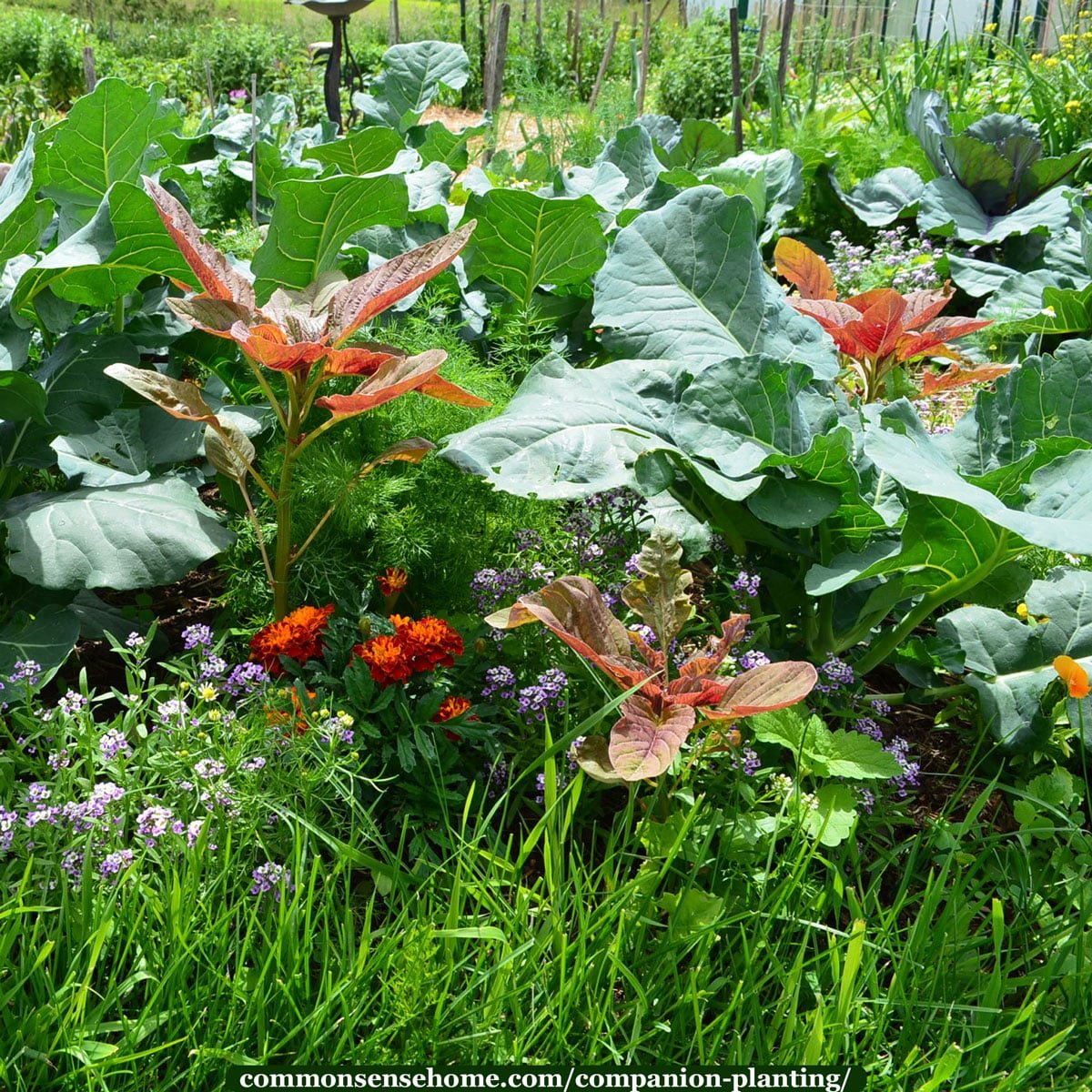
What is Companion Planting in the Garden?
Companion planting is planting different crops near each other to improve the growth of one or both crops.
Sometimes companions attract pollinators or ward off garden pests. Trap crops lure in pests to draw them away from more vulnerable crops. Tall plants can provide needed shade for heat sensitive plants, or act as a trellis for vining crops.
Nitrogen fixing plants like beans, peas, and clover help feed other plants, and plants with deep roots pull up nutrients from the subsoil. Low growing purslane, alyssum, and clover act as ground covers to protect the soil and reduce weeds.
You can read the post, “5 Reasons I Want Weeds in my Garden” to learn more about the use of weeds as ground covers, for soil building and for attracting beneficial insects.
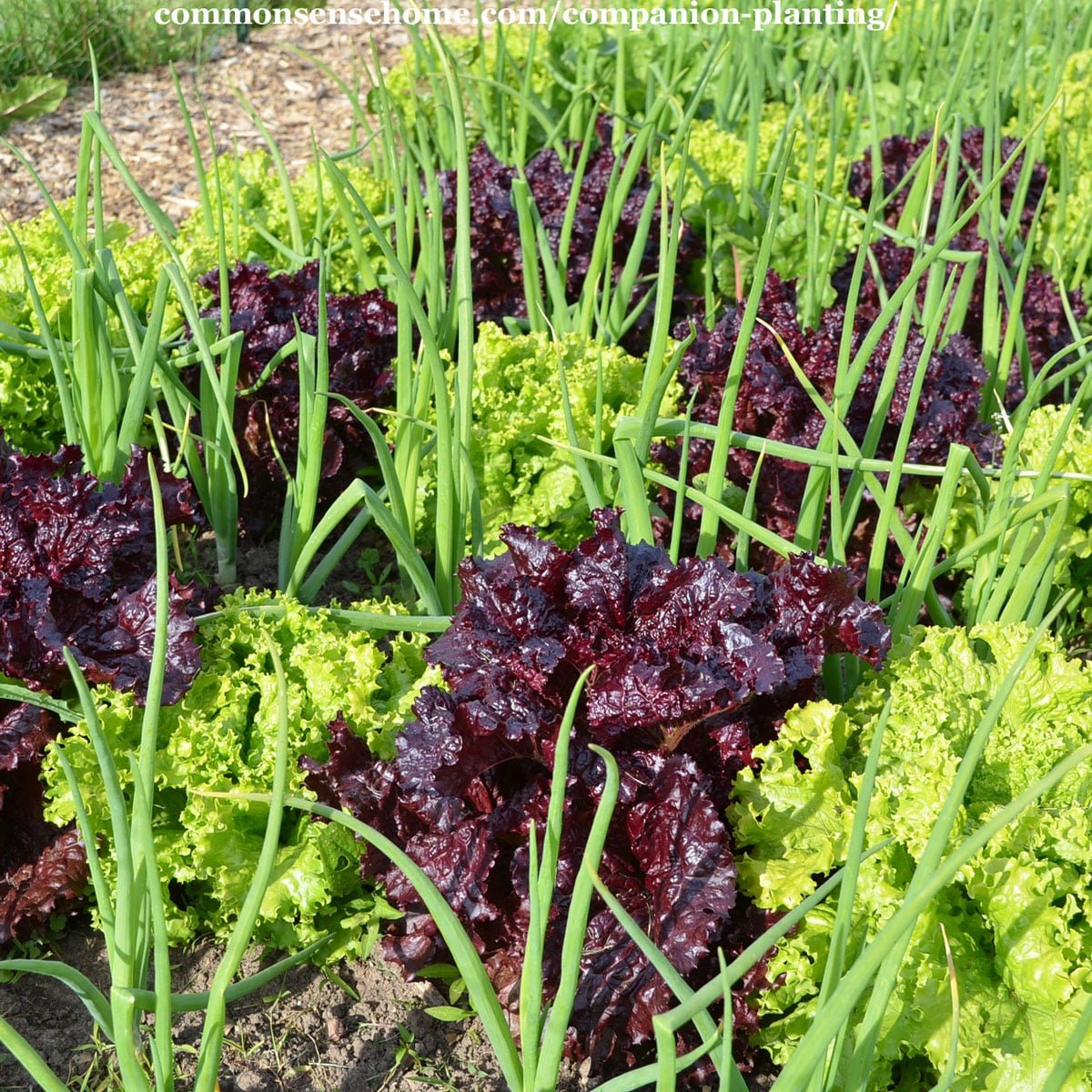
The Easiest Way to Use Companion Planting
Here’s my super simple tip for companion planting – put smelly herbs and flowers all over your garden.
Then, apply common sense, and experiment, and find out what works for your growing conditions.
Think about growth habits – use tall plants or trellised plants to shade shorter ones that can’t stand the heat. Use low growing plants as a living mulch (but make sure to avoid overcrowding).
Strike a balance between keeping a crop concentrated enough for easy harvest, and growing other plants mixed in to repel pests.
If different plants tend to struggle with the same pests or diseases, don’t plant them near each other. For instance, peas and cucumbers may get powdery mildew in humid conditions, and both tomatoes and potatoes can be hit by blight. Avoid planting these crops right next to each other.
Companion planting guides generally recommend avoiding planting beans or peas and onions near each other. Some people mix them without problems, others find that both crops do poorly mixed together.
What’s going on? The answer may be in the rhizosphere, the soil right next to the plant roots that is impacted by the chemicals secreted by the roots.
Beans and peas partner with nitrogen producing bacteria to fix nitrogen in the soil. Onion family plants may produce naturally antibacterial substances from their roots. Under the right conditions, the onions might knock out the nitrogen producing bacteria.
I plant my onions near the edge of the bean patch, and haven’t had any troubles, but my neighbor mixed the two and both failed to thrive. If you’ve trying mixing the two, I’d love to hear your results.
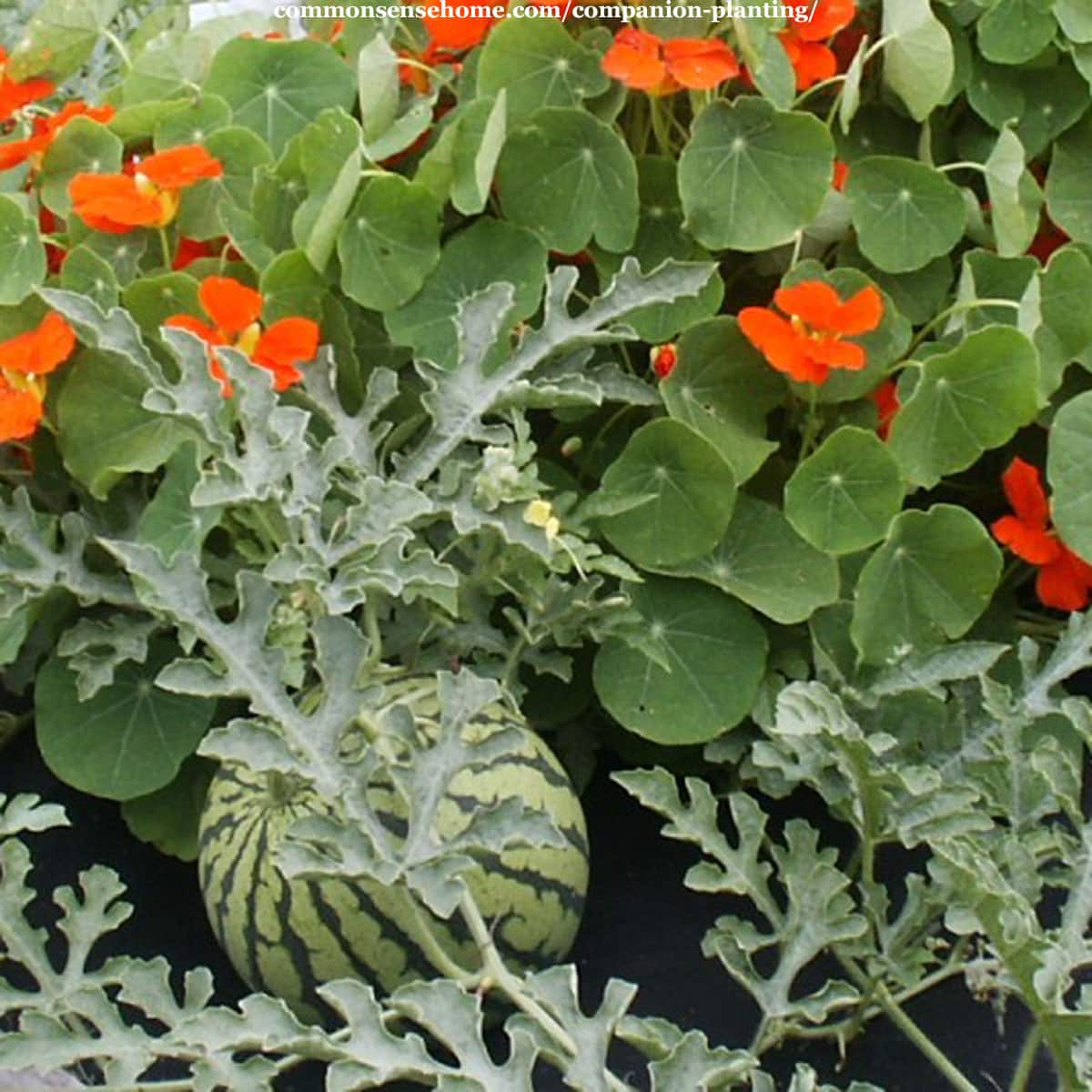
Flowers are Good Companions for Almost Everything
I love the look of sweet alyssum and lobelia, and they do well in my garden. They are low growing, and can be tucked just about anywhere as a ground cover. Alyssum, dill, cilantro, parsley, and yarrow also help attract parasitizing wasps, which feed on caterpillars like tomato hornworms.
Nasturtiums always have a place in my vegetable garden for their beauty, and they repel aphids, bean beetles and squash bugs. They can act as a trap crop to lure blackflies away from fava beans, and cabbage butterflies away from brassicas.
Borage free ranges all over my garden. The bees love it, and it deters tomato worms and boosts strawberry and squash growth.
Marigolds, garlic, and chives deter Japanese beetles and Mexican bean beetles. Marigolds may also stimulate vegetable growth and deter pests such as aphids, potato bugs, squash bugs, and bean beetles.
Would you like to save this?
Volunteer cosmos, calendula, and chamomile pop up all over the garden. I thin them as needed – the bees and butterflies enjoy them all. Think about providing blossoms from the last spring frost until after fall frost to keep the bees fed.
Don’t Forget the Herbs!
I tuck culinary herbs all over the garden, too. Basil repels flies, mosquitoes, aphids, and spider mites. Yarrow can enhance the flavor and scent of some other plants, so I like to work with the herbs and the yarrow together.
Rosemary and sage deter carrot flies, and rosemary also slows down bean beetles and cabbage moths.
Mint is great for deterring aphids, ants, and flea beetles, but it also spreads rapidly and is difficult to eliminate. If you want to use it in your veggie garden, keep it in a sunken pot so it doesn’t take over.
Catnip, which is in the mint family, also repels insect pests and attracts pollinators. (Our bees made some amazing catnip honey last year.)
Catnip has a clumping root habit and is easier to control. It may attract cats, which helps to keep down rodent populations, but the cats sometimes dig in garden beds or roll in the catnip. I keep my catnip plants along the edges of garden beds.
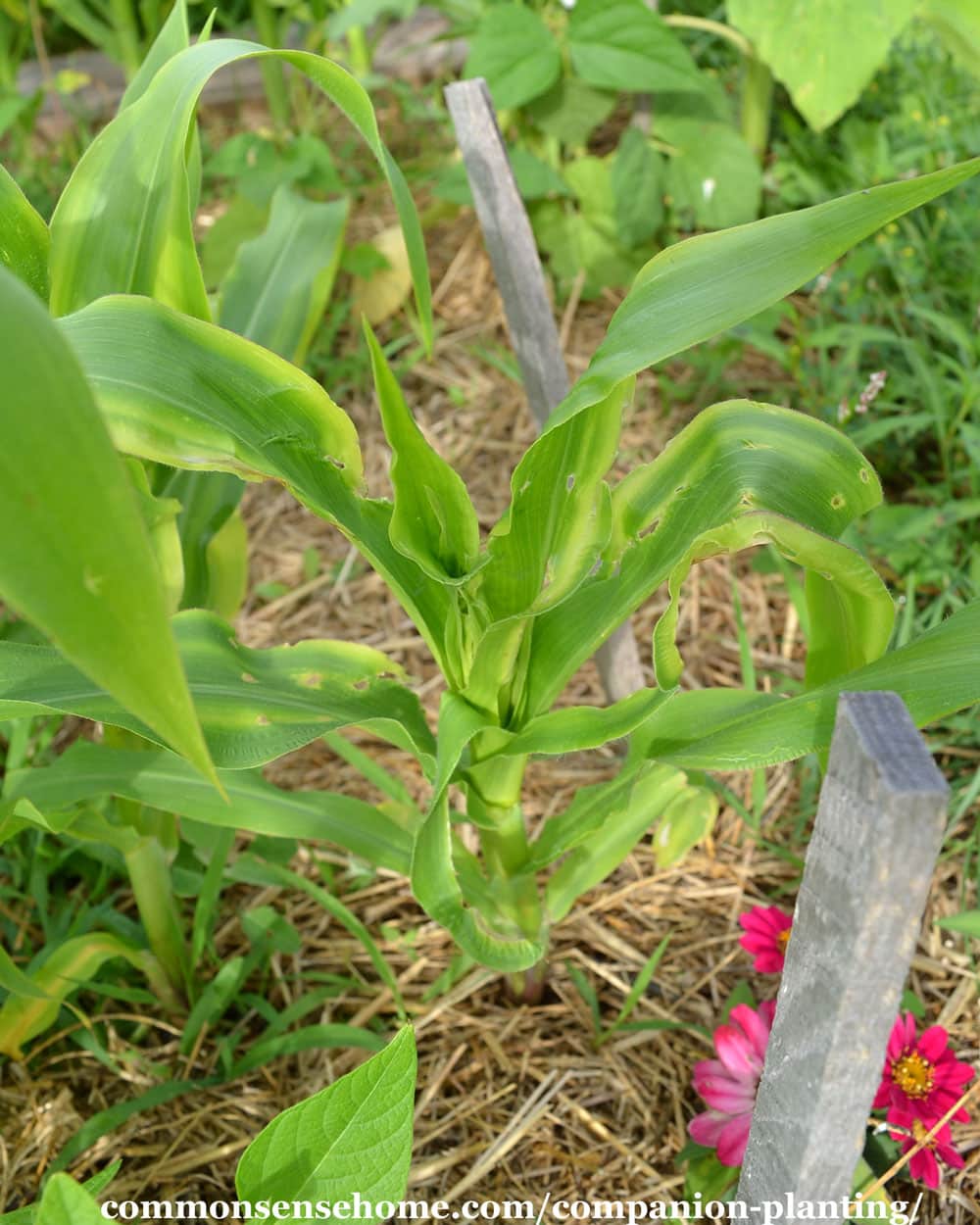
3 Sisters Planting
Three sisters companion planting combines:
- Squash family crops
- Corn
- Pole Beans
In a traditional Native American Three Sisters planting, the corn and beans are both drying types harvested at the end of the season, so you don’t need to get in to harvest during the growing season.
For detailed suggestions on plant spacing and suggested varieties, see The Resilient Gardener.
I found that planting sweet corn and pole beans together did not work well in my northern garden. The corn was crushed by the beans before it could get well established. Similarly, planting the corn and squash together led to the squash strangling the corn.
What did work well for me was to plant the squash in hills placed at intervals around the corn patch, and allowing some vines to trail into the patch once the corn was established. This helps keep the raccoons at bay.
If you want to combine corn and bush beans, make sure to space the corn rows wide enough that the bean plants get enough sunlight and air circulation.
Companion Planting Chart
| Plant | Good Companions/Allies | Avoid Planting With |
| Asparagus | Basil, calendula, parsley, tomatoes | Onion, chive, garlic, leek |
| Beans | Carrot, cauliflower, celeriac, celery, chard, corn, cucumber, eggplant, marigold, parsnip, pea, potato, rosemary, petunias | Basil, fennel, kohlrabi, onion family, radish, sunflower. Onion family plants stunt bean growth. |
| Beets | Bush beans, cabbage family, corn, leek, lettuce, lima beans, onion, radish | Pole beans, mustard |
| Broccoli and other Cabbage family plants (Brussel sprouts, cabbage, cauliflower, Chinese cabbage) | Bush beans, beets, carrots, celery, chard, cucumber, dill, lettuce, nasturtiums, onion family, oregano, potato, rosemary, sage, spinach, catnip | Pole and snap beans |
| Carrots | Bean, Brussel sprouts, cabbage, chive, leaf lettuce, leek, onion, peas, pepper, radish, rosemary, sage, tomato | Celery, dill, parsnip are in the same family so attract the same pests. |
| Celery | Beans, cabbage family, and onions. Low growing alyssum helps shade celery stalks. | Carrot, parsley, parsnip |
| Corn | Bush beans, beets, cabbage, cantaloupe, cucumber, parsley, pea, pumpkins, squash. Plant vine crops around the edge for easier harvest & more light. | Tomatoes and corn are attacked by the same worm (corn earworm/ tomato fruitworm). |
| Cucumbers | Bush beans, broccoli, cabbage family, corn, dill, eggplant, lettuce, nasturtium, radish, sunflower | Aromatic herbs such as sage may stunt cucumber growth. |
| Eggplant | Bush beans, pea, peppers, marigold | Fennel |
| Garlic | Beet, lettuce. Garlic deters Japanese beetles and aphids. | Bean, peas |
| Kale | Bush beans, beets, celery, cucumber, lettuce, onion, potato, aromatic herbs, marigolds | Pole beans, tomatoes |
| Lettuce | Carrots, garlic, onion, radish, chives | |
| Melons and Watermelons | Corn, radish, marigolds, nasturtiums, oregano | Potato |
| Onions | Beets, cabbage family, carrot, kohlrabi, early lettuce, parsnip, pepper, spinach, tomato, turnip | Asparagus, beans, peas, sage. Onions are antibacterial, and beans/peas fix nitrogen using bacteria. |
| Peas | Carrot, celery, chicory, corn, eggplant, parsley, early potato, radish, spinach, sweet pepper, turnip | Onion family, late potato |
| Peppers | Carrot, onion, parsnip, pea | Fennel, kohlrabi |
| Potatoes | Bush beans, cabbage family, corn, marigold, parsnip, pea. Basil deters potato beetles. | Cucumber, pumpkin, rutabaga, squash family, sunflower, tomato, turnip. Cucumbers may encourage blight in late potatoes. |
| Sweet potatoes | Marigold | Beets, carrots, potatoes |
| Swiss chard | Bush beans, kohlrabi, onions | Pole beans |
| Radish | Lettuce, beans, beets, carrot, nasturtium, parsnip, pea, spinach. Radishes attract flea beetles & can act as a trap crop. | Fennel |
| Tomatoes | Asparagus, basil, bush beans, carrot, celery, chive, garlic, head lettuce, marigold, nasturtium, onion, parsley, pepper, borage | Pole beans, dill, fennel, potato, corn, kohlrabi |
| Winter Squash and Pumpkins | Celeriac, celery, corn, onion, radish | Potatoes |
| Zucchini/Summer Squash | Celeriac, celery, corn, nasturtium, onion, radish | Potatoes |
Download the chart in Printable PDF format here.
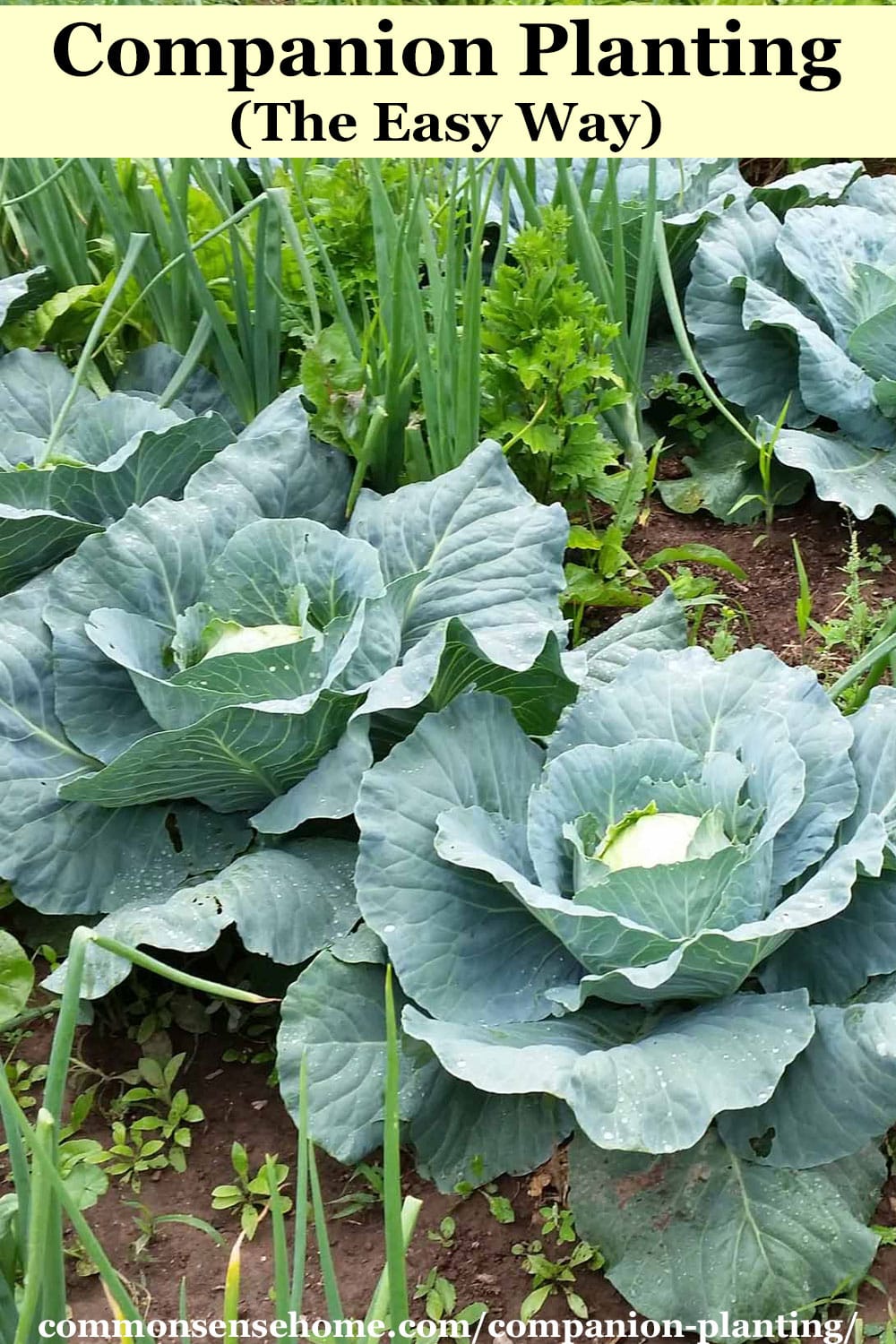
Companion Planting Books
I loosely adapt the concepts presented in the book “Great Garden Companions”. Carrots Love Tomatoes, and its companion book for flowers, “Roses Love Garlic” are also popular.
You may also enjoy:
- How to Start a Garden
- Printable Garden Journal Templates
- When Should I Start My Seeds? Printable seed starting calendar
Originally published in 2016, last updated in 2022.


I’ve successfully grown corn with squash by planting the corn in a circle around each squash plant using six to eight inch spacing around the circle and not crowding the squash too much. The squash leaves poke between and beyond the corn and get plenty of sun.
Can hollyhocks be grown with lettuce? Or which vegetables?
I’d use them on the north side of a bed, unless you need them for shade for plants that don’t like too much heat, like lettuce.
Marigolds and zinnias are my favorites to add to the garden, whether ‘yard’ gardening or container gardening.
I love those, too, and so do the butterflies, especially the zinnias.
Its fun to see so many companion plants on your lists that re-emerge each year in my up north zone 3 garden. The good companions that self-seed are wild asters, ox eyed daisies, yarrow, common and Chinese plantain and self-heal. Of course we variously appreciate dandelions, both wild and Italian, burdock, salsify, nettles and thistles of various kinds. The only welcome self seeding companion that I have introduced is borage, my big bee buddy. There are some less welcome plants that self seed. It was so disappointing to discover that my lovely, tenacious buttercups were deathly poisonous. They have become an ongoing opportunity for becoming more skilled at invasives management. I hope that others eventually report ways to recruit these guys to play with us in our gardens.
I planted borage once – it’s come back every year since. The bees love it, and it’s easy to pull where I need room.
we are up in the NorthEast –adirondack mountains, zone 4. I love nasturtiums in the squash—great color and textures. I also plant and replant marigolds everywhere, the single ones are my fave, the ones that get nice and bushy and no taller than 10-12″ or so. They look wonderful around everything, and smell divine. My cilantro and dill self-seed through out as well, and this is a nice delicate look among heavy leaved things like kale and B sprouts.
Thank you for this extensive post. I have tried companion planting. Not sure how much success I got, because we are still working on turning out clay ground into better garden ground. And I haven’t found anything that deters fire ants yet.
But I keep trying, so thank you! I will look for that book when I get a little extra money. I am going to bookmark your post so you get the credit.
A Blessed Easter to you and yours.